The Chestnut-winged Cuckoo (Clamator coromandus) is a captivating avian species renowned for its striking appearance and distinct vocalizations.
This medium-sized cuckoo, characterized by its chestnut-colored wings and contrasting black-and-white plumage, is native to South and Southeast Asia.
Often found in dense forests, the Chestnut-winged Cuckoo is known for its elusive nature, making sightings a delight for bird enthusiasts.
Its melodious call, resembling the sound of a wooden clog striking a hard surface, adds to the mystique surrounding this species.
With a varied diet that includes insects, caterpillars, and even small reptiles, the Chestnut-winged Cuckoo plays a vital role in the ecological balance of its habitat.
Studying this unique bird’s behavior and ecological interactions contributes to a deeper understanding of avian biodiversity. It underscores the importance of conservation efforts in preserving the habitats it calls home.
Identification Criteria of Chestnut-winged Cuckoo
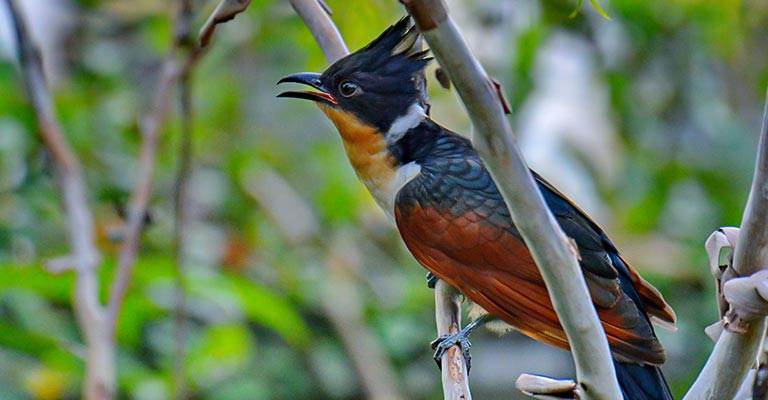
Identifying the Chestnut-winged Cuckoo (Clamator coromandus) requires a keen eye and an understanding of its distinctive features, as this bird possesses a unique combination of physical characteristics and behaviors.
Here are eight key points to help in the accurate identification of the Chestnut-winged Cuckoo:
Distinctive Plumage
The most prominent feature of the Chestnut-winged Cuckoo is its striking plumage. The bird exhibits a black head and upper body and a contrasting white underbelly.
However, what truly sets it apart is the distinctive chestnut-colored wings, which become especially noticeable during flight. These wings serve as a primary field mark for quick and accurate identification.
Size and Shape
The Chestnut-winged Cuckoo falls into the category of medium-sized cuckoos, with a length ranging from 32 to 35 centimeters. Its slender body and long tail contribute to an elegant silhouette.
Observers should note the overall proportions, keeping an eye out for the bird’s elongated tail, which aids in distinguishing it from other avian species in its habitat.
Facial Features
Examining the facial characteristics is crucial for identification. The Chestnut-winged Cuckoo has a distinctive black facial mask that extends from the bill to the nape of the neck.
The eyes are surrounded by bare yellow skin, adding a unique and easily recognizable touch to its appearance.
Vocalizations
The bird’s vocalizations provide another valuable clue for identification. The Chestnut-winged Cuckoo is known for its rhythmic and repetitive call, resembling the sound of a wooden clog being struck against a hard surface.
Familiarizing oneself with this unique auditory signature can aid birdwatchers in locating and confirming the presence of this species.
Behavioral Traits
Observing the behavior of the Chestnut-winged Cuckoo can offer valuable insights. This species is known for its elusive nature, often hidden within the foliage.
However, it may become more visible during territorial displays or courtship rituals. Patient observation of its foraging habits, such as hunting for insects and caterpillars, can also aid identification.
Geographical Range
Knowing the geographical range of the Chestnut-winged Cuckoo is crucial. This species is native to South and Southeast Asia, including India, Bangladesh, Myanmar, Thailand, and Malaysia.
Consulting range maps and distribution guides can help birdwatchers narrow down potential sightings.
Seasonal Migration Patterns
Understanding the seasonal movements of the Chestnut-winged Cuckoo can be beneficial for identification. While some populations are known to be resident, others may exhibit migratory behavior.
Observing migration patterns, if applicable to the region, can provide additional context for confirming the presence of this unique cuckoo.
Identifying the Chestnut-winged Cuckoo requires a holistic approach that considers its plumage, size, facial features, vocalizations, habitat preferences, behavior, geographical range, and, if relevant, seasonal migration patterns.
Birdwatchers armed with these key points will be well-equipped to distinguish this captivating species from its avian counterparts in the diverse landscapes it inhabits.
Taxonomy of Chestnut-winged Cuckoo
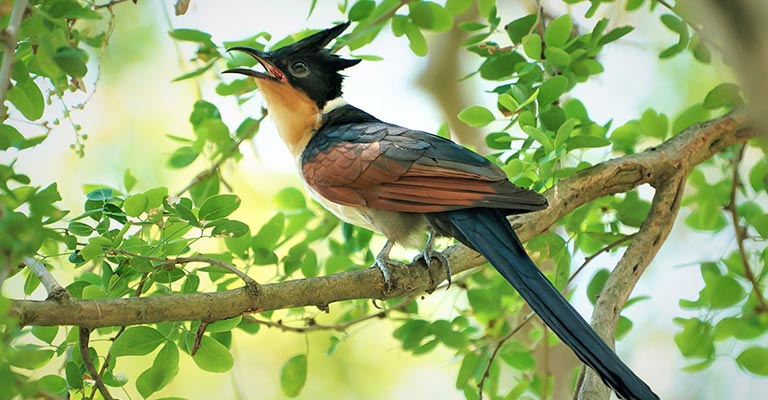
Here’s a table summarizing the taxonomy details of the Chestnut-winged Cuckoo (C. coromandus):
| Taxonomic Level | Classification |
| Domain | Eukaryota |
| Kingdom | Animalia |
| Phylum | Chordata |
| Class | Aves |
| Order | Cuculiformes |
| Family | Cuculidae |
| Genus | Clamator |
| Species | C. coromandus |
The Chestnut-winged Cuckoo (Clamator coromandus) belongs to the avian class Aves, order Cuculiformes, and family Cuculidae. Within the Cuculidae family, it is part of the subfamily Cuculinae.
The genus Clamator encompasses several cuckoo species, with the Chestnut-winged Cuckoo being one of its distinctive members.
Its scientific name, Clamator coromandus, reflects its taxonomic classification. Endemic to South and Southeast Asia, this medium-sized cuckoo is characterized by its black-and-white plumage, chestnut wings, and unique vocalizations.
Understanding the taxonomy of the Chestnut-winged Cuckoo provides a systematic framework for studying and appreciating its evolutionary relationships within the avian lineage.
Chestnut-winged Cuckoo Life History
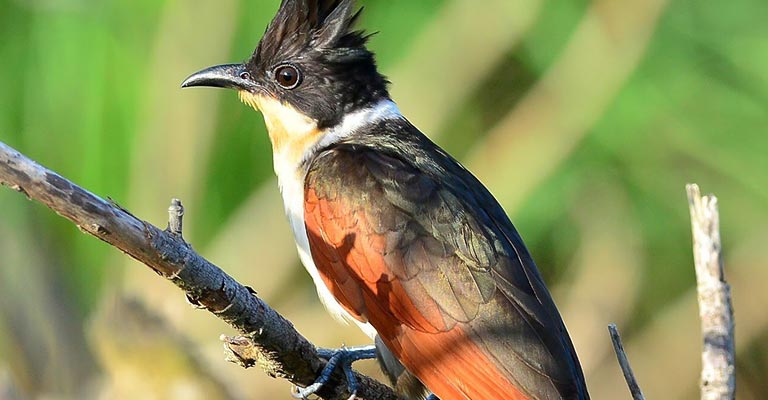
The Chestnut-winged Cuckoo (Clamator coromandus) presents an intriguing life history shaped by its distinctive features and behaviors.
From its preferred habitats to breeding patterns and conservation concerns, exploring various aspects of this bird’s life provides valuable insights into its ecological role and challenges.
Habitat
The Chestnut-winged Cuckoo thrives in dense forests, often favoring lowland and foothill areas. Additionally, it can be found in wooded gardens and edges, demonstrating its adaptability to various forested environments.
The habitat choice reflects its dependence on the availability of suitable cover and a diverse range of prey.
Range Map
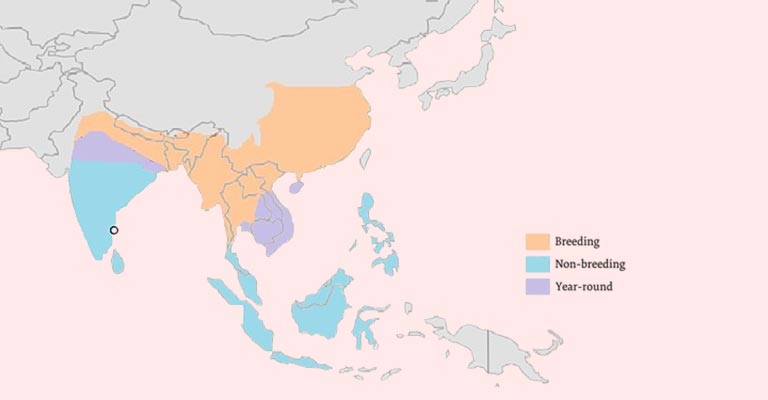
The species is native to South and Southeast Asia, with its range extending across countries like India, Bangladesh, Myanmar, Thailand, and Malaysia.
A detailed exploration of the Chestnut-winged Cuckoo’s range map aids in understanding its distribution, migratory patterns, and potential conservation considerations.
Breeding
Breeding in the Chestnut-winged Cuckoo typically occurs during the monsoon season, with variations in timing based on geographical location.
During courtship displays, the distinctive call of the male becomes more pronounced. Breeding pairs engage in aerial pursuits, showcasing their commitment to reproduction and territorial establishment.
Nesting
The bird is known for its secretive nesting habits, often building nests in well-concealed locations within the forest canopy. The cup-shaped nest is constructed with twigs and other plant materials. Eggs are typically laid directly on the nest floor.
Understanding these nesting behaviors is essential for researchers and conservationists aiming to protect and preserve breeding habitats.
| Nesting Parameter | Information |
| Clutch Size | Usually 2 eggs |
| Number of Broods | Single brood per breeding season |
| Egg Length | Approximately 28 to 30 mm |
| Egg Width | Approximately 22 to 24 mm |
| Incubation Period | Around 13 to 16 days |
| Nestling Period | Approximately 18 to 20 days |
| Egg Description | Elliptical, smooth surface, and white with a slight gloss |
| Nest Construction | Constructed in concealed locations within the forest canopy, using twigs and plant materials |
| Parental Care | Both parents contribute to incubation and care for the nestlings |
| Fledgling Appearance | Resembles adult plumage, with the distinctive black-and-white coloration and chestnut wings |
| Nesting Habitat | Dense forests, often in lowland and foothill areas |
| Breeding Season | Primarily during the monsoon season |
| Courtship and Mating | Involve aerial displays, with males showcasing their unique call and engaging in pursuits with females |
Diseases
Like many bird species, the Chestnut-winged Cuckoo is susceptible to various diseases impacting its health and reproductive success.
Avian diseases, including those transmitted by parasites, can threaten individual birds and populations. Monitoring and identifying signs of diseases are crucial for implementing effective conservation measures.
Treatment
Conservation efforts often involve addressing health concerns to ensure the well-being of the Chestnut-winged Cuckoo. Treatment may include measures to control the spread of diseases, habitat restoration, and public awareness initiatives.
Collaborative efforts between wildlife experts, veterinarians, and conservation organizations play a pivotal role in mitigating health-related challenges.
Conservation
The Chestnut-winged Cuckoo faces conservation challenges due to habitat loss, deforestation, and potential climate change impacts.
Conservation initiatives focus on preserving critical habitats, implementing sustainable forestry practices, and raising awareness about the significance of this species in maintaining ecological balance.
Captive breeding programs and research on the species’ behavior further contribute to conservation endeavors.
Unraveling the life history of the Chestnut-winged Cuckoo unveils a fascinating journey encompassing habitat preferences, breeding strategies, nesting behaviors, health concerns, and ongoing efforts to ensure its conservation.
Understanding and appreciating the intricacies of this bird’s life story is crucial for developing effective conservation strategies and fostering a harmonious coexistence between this unique cuckoo species and its environment.
Food Habit of Chestnut-winged Cuckoo
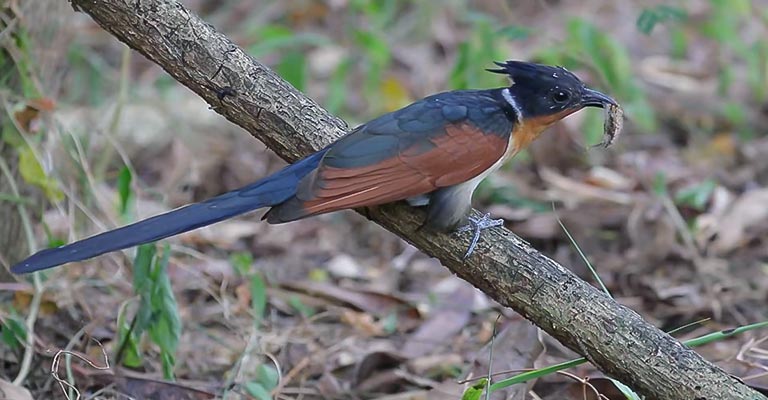
The Chestnut-winged Cuckoo (Clamator coromandus) exhibits a diverse and insect-centric food habit, contributing to its ecological role within its habitat. This bird’s diet primarily consists of various invertebrates, with a particular emphasis on insects and caterpillars.
The foraging behavior of the Chestnut-winged Cuckoo involves actively searching for prey among the dense foliage of trees and shrubs.
This cuckoo species is known to feed on many insects, including grasshoppers, beetles, and moths. Its slender and agile build allows it to navigate through the intricate branches and leaves, reaching its prey efficiently.
The Chestnut-winged Cuckoo employs a sit-and-wait strategy, patiently observing its surroundings before making quick and precise strikes to capture insects.
Additionally, the Chestnut-winged Cuckoo has been observed consuming small reptiles, further diversifying its diet. This adaptable approach to feeding highlights the bird’s ability to utilize the resources available in its habitat effectively.
10 Behavioral Habits of Chestnut-winged Cuckoo
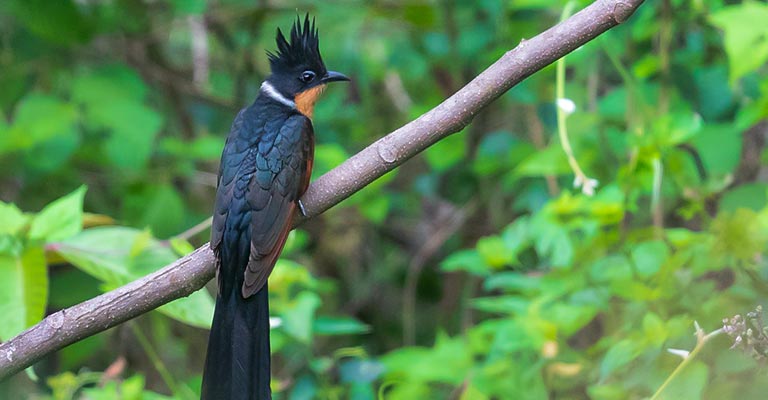
The Chestnut-winged Cuckoo (Clamator coromandus) showcases a fascinating array of behavioral habits contributing to its adaptability and survival within its habitat.
From foraging strategies to courtship rituals, understanding these behavioral patterns sheds light on the intricate life of this enigmatic cuckoo.
Foraging Techniques
The Chestnut-winged Cuckoo employs a sit-and-wait foraging strategy, patiently observing its surroundings before making swift strikes to capture insects.
Its slender and agile build allows it to navigate the dense foliage precisely.
Territorial Calls
Males are known for their distinct and rhythmic calls, resembling the sound of a wooden clog striking a hard surface. These calls not only establish territory but also play a crucial role in courtship displays.
Courtship Displays
During the breeding season, elaborate courtship displays are observed. Males showcase their unique vocalizations, engage in aerial pursuits, and present a series of acrobatic maneuvers to attract potential mates.
Parental Care
Both male and female Chestnut-winged Cuckoos actively contribute to incubating the eggs and caring for the nestlings.
This shared parental responsibility ensures the offspring’s well-being during their vulnerable stages.
Migratory Behavior
While some populations are resident, the Chestnut-winged Cuckoo may exhibit migratory behavior in certain regions. Understanding these seasonal movements contributes to a comprehensive grasp of their ecological dynamics.
Adaptability to Various Habitats
The species demonstrates adaptability by thriving in diverse forested environments, including lowland and foothill areas and wooded gardens and edges.
This adaptability enhances its ability to find suitable foraging and nesting locations.
Social Interaction
Chestnut-winged Cuckoos display social behavior, especially during the breeding season.
Interactions involve courtship rituals, territorial displays, and communication through calls, establishing social hierarchies.
Fledgling Independence
Once the nestlings fledge, they resemble adult plumage and gain independence swiftly. This early maturity is essential for their survival in the dynamic and often challenging forest environment.
Dietary Preferences
The primary diet of the Chestnut-winged Cuckoo consists of insects, caterpillars, and small reptiles. This dietary diversity reflects the bird’s ability to adapt its foraging habits based on prey availability.
The Chestnut-winged Cuckoo’s behavioral habits are a testament to its resilience and versatility in navigating the intricacies of its natural environment.
These habits, ranging from foraging techniques to social interactions, contribute to the species’ overall success within the ecosystems it calls home.
Wrapping Up
In unraveling the behavioral intricacies of the Chestnut-winged Cuckoo, we discover a bird uniquely adapted to its environment.
From its distinctive vocalizations and courtship displays to shared parental care and dietary preferences, each behavioral facet contributes to the species’ ecological role.
The cuckoo’s ability to thrive across diverse habitats underscores the importance of understanding its nuanced behaviors for practical conservation efforts.
As we delve into the rich tapestry of its life, the Chestnut-winged Cuckoo emerges not only as a captivating subject of study but also as a vital player in the delicate balance of its ecosystems.